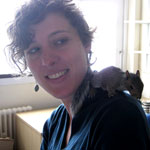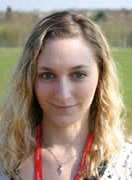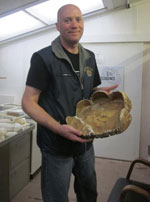This email address is being protected from spambots. You need JavaScript enabled to view it.
 Department of Veterinary Basic Sciences and Structure and Motion Laboratory
Department of Veterinary Basic Sciences and Structure and Motion Laboratory
The Royal Veterinary College, AL97TA
United Kingdom
Julia Molnar received her MA in biological and medical illustration at Johns Hopkins University in 2009. She joined the Structure and Motion Lab in 2009 as a Scientific Illustrator and research technician. In 2010 she began a PhD in the evolutionary biomechanics of early tetrapods and crocodylomorphs. Her research interests include fossil reconstruction, 3D modelling, and biomechanics.
This email address is being protected from spambots. You need JavaScript enabled to view it.
 University Museum of Zoology
University Museum of Zoology
Department of Zoology
University of Cambridge
Cambridge, CB2 3EJ
United Kingdom
and
Department of Veterinary Basic Sciences and Structure and Motion Laboratory
The Royal Veterinary College, AL97TA
United Kingdom
Stephanie Pierce received her PhD from Bristol University (2007) which focused on assessing the interplay between skull shape variation and biomechanical performance in extant and extinct crocodiles. Stephanie is currently a post-doc on a NERC funded project entitled “Locomotion in the earliest tetrapods: testing models of terrestriality” in the Museum of Zoology, Cambridge and at the Royal Veterinary College. Stephanie's scholarly interests are focused on assessing the link between form and function of the vertebrate skeletal system – especially with respect to muscle/skeletal interactions during feeding and locomotor behaviours in modern and extinct animals.
This email address is being protected from spambots. You need JavaScript enabled to view it.
 Department of Zoology
Department of Zoology
University of Cambridge
Cambridge, CB2 3EJ
United Kingdom
Jenny Clack FRS is a vertebrate palaeontologist at Cambridge University, UK. She did her PhD at the University of Newcastle upon Tyne (1984). Her research area is the origin, phylogeny and radiation of early tetrapods and their relatives among the lobe-finned fish, the "fish-tetrapod" transition, and the evolution of terrestrially. She is best-known for her book Gaining Ground: The Origin and Early Evolution of Tetrapods, published in 2002.
This email address is being protected from spambots. You need JavaScript enabled to view it.
 Department of Veterinary Basic Sciences and Structure and Motion Laboratory
Department of Veterinary Basic Sciences and Structure and Motion Laboratory
The Royal Veterinary College, AL97TA
United Kingdom
John R. Hutchinson did his PhD at the University of California (Berkeley) in Integrative Biology in 2001, followed by a fellowship in Biomechanical Engineering / bioinformatics at Stanford, then started at the RVC as a Lecturer in Evolutionary Biomechanics in 2003 in the Department of Veterinary Basic Sciences and was promoted to Reader in 2008, then Professor in 2011. His interests are in the evolutionary biomechanics of locomotion, especially in large terrestrial vertebrates. He has studied birds, extinct dinosaurs and their relatives, elephants, crocodiles, felids, and now early tetrapods, using a diversity of techniques from basic morphology to experimentation and computer modelling/simulation.

